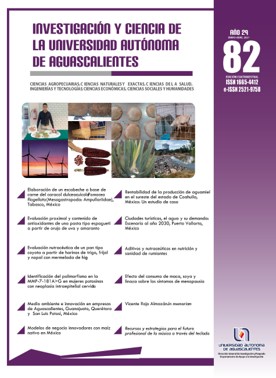Environment and innovation in firms of Aguascalientes, Guanajuato, Queretaro and San Luis Potosi, Mexico
DOI:
https://doi.org/10.33064/iycuaa2021823541Keywords:
nnovation, firms, ISO 14001, Clean Industry, environmental audit, AguascalientesAbstract
In this paper we studied the effect of two voluntary environmental programs (ISO 14001 and Clean Industry) on product, process, organisational and marketing innovation of companies located in Aguascalientes, Guanajuato, Queretaro and San Luis Potosi. The biprobit probabilistic method was used, and a sample of 1,663 firms from the four entities and which were extracted from the Encuesta sobre Investigacion y Desarrollo Tecnologico 2014. The results reveal that there is a positive and significant effect on the probability that companies in this region innovate in products, process, organisational or marketing when they adopt the ISO 14001 standard or the Clean Industry certification. The finding strengthens the hypothesis that voluntary environmental instruments, such as the ISO 14001 standard and the Clean Industry certification, favor innovation activities in companies.
Downloads
References
• Calso Morales, N., & Pardo Álvarez, J. M. (2018). Guía práctica para la integración de sistemas de gestión. ISO 9001, ISO 14001, ISO 45001. Madrid: AENOR Editores.
• Carrión-Flores, C. E., Innes, R., & Sam, A. G. (2013). Do voluntary reduction programs (VPRs) spur or deter environmental innovation? Evidence from 33/50. Journal of Environmental Economics and Management, 66(3), 444-459.
• Chang, C. H., & Sam, A. G. (2015). Corporate environmentalism and environmental innovation. Journal of Environmental Management, 153, 84-92.
• Demirel, P., & Kesidou, E. (2011). Stimulating different types of eco-innovation in the UK: Government policies and firm motivations. Ecological Economics, 70(8), 1546-1557.
• Durán Romero, G. (2007). Empresa y medio ambiente. Políticas de gestión ambiental. Madrid: Ediciones Pirámide.
• GLOBE-Net. (2021). [Fotografía ilustrativa]. Recuperada de https://globe-net.com/wp-content/uploads/2021/04/Picture2-400x230.jpg
• Greene, W. H. (1996). Marginal effects in the bivariate probit model. NYU Working Paper No. EC-96-11. Recuperado de https://pdfs.semanticscholar.org/a0b8/f43bf53a61f3101a36c36cbc7ca59a3ea938.pdf
• Henriques, I., Husted, B. W., & Montiel, I. (2013). Spillover effects of voluntary environmental programs on greenhouse gas emissions: Lessons from Mexico. Journal of Policy Analysis and Management, 32(2), 296-322.
• Hill, R. C., Griffiths, W. E., & Lim, G. C. (2018). Principles of Econometrics. (5a. ed.). US: John Wiley & Sons.
• Instituto Nacional de Estadística y Geografía. (2019). Encuesta sobre Investigación y Desarrollo Tecnológico 2014 - ESIDET. México: Autor.
• Kesidou, E., & Demirel, P. (2012). On the drivers of ecoinnovations: Empirical evidence from the UK. Research Policy, 41(5), 862-870.
• Lambardi, G. D., & Mora, J. J. (2014). Determinantes de la innovación en productos y procesos: El caso colombiano. Revista de Economía Institucional, 16(31), 251-262.
• Leenders, M. A. A. M., & Chandra, Y. (2012). Antecedents and consequences of green innovation in the wine industry: the role of channel structure. Technology Analysis & Strategic Management, 25(2), 203-218. doi: 10.2139/ssrh.2519941
• Llach, J., De Castro, R., Bikfalvi, A., & Marimon, F. (2012). The relationship between environmental management systems and organizational innovations. Human Factors and Ergonomics in Manufacturing & Service Industries, 22(4), 307-316.
• Organisation for Economic Cooperation and Development. (2000). Voluntary approaches for environmental policy: An assessment. doi: 10.1787/9789264180260-en
• __________ (2005). Oslo Manual [pdf descargable]. doi: 10.1787/9789264065659-es
• Porter, M. E., & Van der Linde, C. (1995). Toward a new conception of the environmental-competitiveness relationship. Journal of Economic Perspectives, 9(4), 97-118.
• Procuraduría Federal de Protección al Ambiente. (s.f.). Programa Nacional de Auditoría Ambiental. México: Autor. Recuperado de https://www.gob.mx/cms/uploads/attachment/file/459960/BROCHURE_2019.pdf
• Romo, D., & Hill, P. (2010). Los determinantes de la innovación tecnológica en la industria manufacturera mexicana. En C. Bazdresch Parada, & L. Meza González (Eds.), La tecnología y la innovación como motores del crecimiento de México (pp. 73-135). México: Fondo de Cultura Económica.
• Rueda Manzanares, A., Aragón Correa, J. A., & Martín Tapia, I. (2006). La medición de las capacidades organizacionales de la empresa: Validación de un instrumento de medida de la gestión medioambiental proactiva. Revista Española de Financiación y Contabilidad, 35(130), 563-582.
• Uribe, J. I., Ortiz, C. H., & García, G. A. (2008). Informalidad y subempleo en Colombia: dos caras de la misma moneda. Cuadernos de Administración, 21(37), 211-241.
• Wagner, M. (2007). On the relationship between environmental management, environmental innovation and patenting: Evidence from German manufacturing firms. Research Policy, 36(10), 1587-1602.
• Ziegler, A. (2015). Disentangling technological innovations: A microeconometric analysis of their determinants. Journal of Environmental Planning and Management, 58(2), 315-335.
• Ziegler, A., & Nogareda, J. S. (2009). Environmental management systems and technological environmental innovations: Exploring the causal relationship. Research Policy, 38(5), 855-893.
Downloads
Published
How to Cite
License
Copyright (c) 2021 Roberto González-Acolt, Rubén Macías-Acosta, Luis Lenin Herrera-Díaz de León

This work is licensed under a Creative Commons Attribution-NonCommercial-ShareAlike 4.0 International License.
Las obras publicadas en versión electrónica de la revista están bajo la licencia Creative Commons Atribución-NoComercial-CompartirIgual 4.0 Internacional (CC BY-NC-SA 4.0)
10.52080/rvgluz.29.e12.26
10.29105/mdi.v11i18.276









